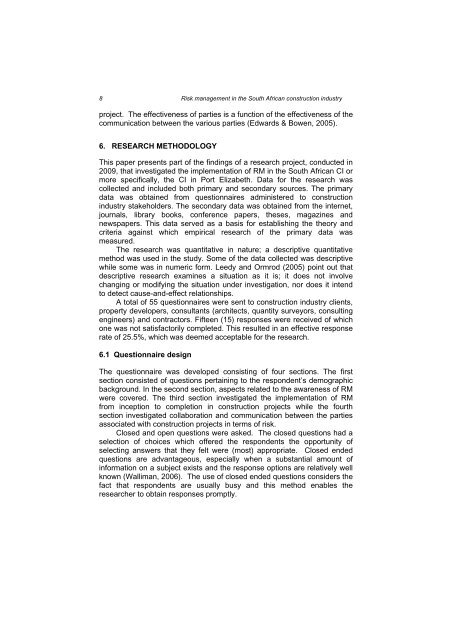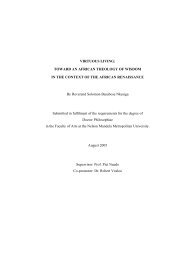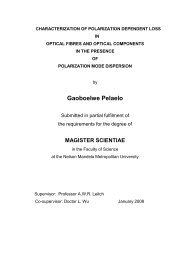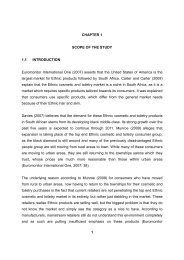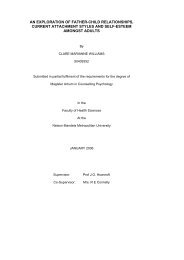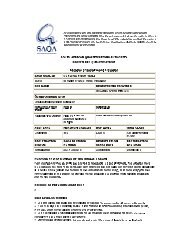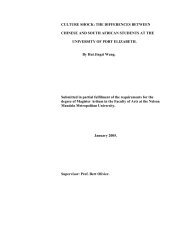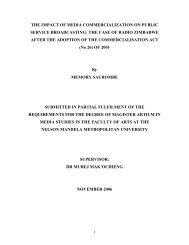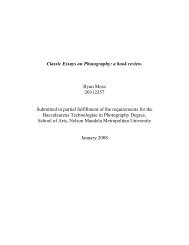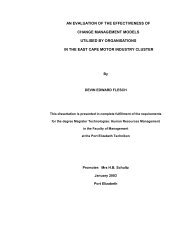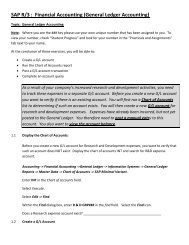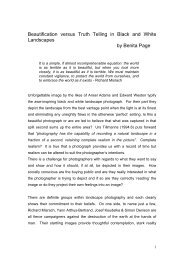Risk management in the South African construction industry
Risk management in the South African construction industry
Risk management in the South African construction industry
You also want an ePaper? Increase the reach of your titles
YUMPU automatically turns print PDFs into web optimized ePapers that Google loves.
8 <strong>Risk</strong> <strong>management</strong> <strong>in</strong> <strong>the</strong> <strong>South</strong> <strong>African</strong> <strong>construction</strong> <strong>in</strong>dustry<br />
project. The effectiveness of parties is a function of <strong>the</strong> effectiveness of <strong>the</strong><br />
communication between <strong>the</strong> various parties (Edwards & Bowen, 2005).<br />
6. RESEARCH METHODOLOGY<br />
This paper presents part of <strong>the</strong> f<strong>in</strong>d<strong>in</strong>gs of a research project, conducted <strong>in</strong><br />
2009, that <strong>in</strong>vestigated <strong>the</strong> implementation of RM <strong>in</strong> <strong>the</strong> <strong>South</strong> <strong>African</strong> CI or<br />
more specifically, <strong>the</strong> CI <strong>in</strong> Port Elizabeth. Data for <strong>the</strong> research was<br />
collected and <strong>in</strong>cluded both primary and secondary sources. The primary<br />
data was obta<strong>in</strong>ed from questionnaires adm<strong>in</strong>istered to <strong>construction</strong><br />
<strong>in</strong>dustry stakeholders. The secondary data was obta<strong>in</strong>ed from <strong>the</strong> <strong>in</strong>ternet,<br />
journals, library books, conference papers, <strong>the</strong>ses, magaz<strong>in</strong>es and<br />
newspapers. This data served as a basis for establish<strong>in</strong>g <strong>the</strong> <strong>the</strong>ory and<br />
criteria aga<strong>in</strong>st which empirical research of <strong>the</strong> primary data was<br />
measured.<br />
The research was quantitative <strong>in</strong> nature; a descriptive quantitative<br />
method was used <strong>in</strong> <strong>the</strong> study. Some of <strong>the</strong> data collected was descriptive<br />
while some was <strong>in</strong> numeric form. Leedy and Ormrod (2005) po<strong>in</strong>t out that<br />
descriptive research exam<strong>in</strong>es a situation as it is; it does not <strong>in</strong>volve<br />
chang<strong>in</strong>g or modify<strong>in</strong>g <strong>the</strong> situation under <strong>in</strong>vestigation, nor does it <strong>in</strong>tend<br />
to detect cause-and-effect relationships.<br />
A total of 55 questionnaires were sent to <strong>construction</strong> <strong>in</strong>dustry clients,<br />
property developers, consultants (architects, quantity surveyors, consult<strong>in</strong>g<br />
eng<strong>in</strong>eers) and contractors. Fifteen (15) responses were received of which<br />
one was not satisfactorily completed. This resulted <strong>in</strong> an effective response<br />
rate of 25.5%, which was deemed acceptable for <strong>the</strong> research.<br />
6.1 Questionnaire design<br />
The questionnaire was developed consist<strong>in</strong>g of four sections. The first<br />
section consisted of questions perta<strong>in</strong><strong>in</strong>g to <strong>the</strong> respondent’s demographic<br />
background. In <strong>the</strong> second section, aspects related to <strong>the</strong> awareness of RM<br />
were covered. The third section <strong>in</strong>vestigated <strong>the</strong> implementation of RM<br />
from <strong>in</strong>ception to completion <strong>in</strong> <strong>construction</strong> projects while <strong>the</strong> fourth<br />
section <strong>in</strong>vestigated collaboration and communication between <strong>the</strong> parties<br />
associated with <strong>construction</strong> projects <strong>in</strong> terms of risk.<br />
Closed and open questions were asked. The closed questions had a<br />
selection of choices which offered <strong>the</strong> respondents <strong>the</strong> opportunity of<br />
select<strong>in</strong>g answers that <strong>the</strong>y felt were (most) appropriate. Closed ended<br />
questions are advantageous, especially when a substantial amount of<br />
<strong>in</strong>formation on a subject exists and <strong>the</strong> response options are relatively well<br />
known (Walliman, 2006). The use of closed ended questions considers <strong>the</strong><br />
fact that respondents are usually busy and this method enables <strong>the</strong><br />
researcher to obta<strong>in</strong> responses promptly.


